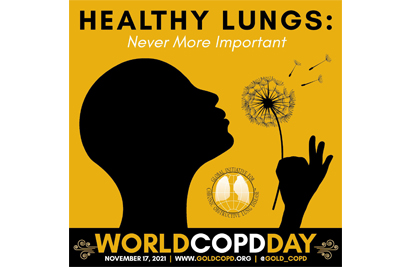
Since 2002, the World Chronic Obstructive Pulmonary Disease Day (World COPD Day) has been held annually at the initiative of the World Health Organization, which is celebrated on November 17 this year.
Chronic obstructive pulmonary disease (COPD) is a common, preventable and treatable chronic lung disease that affects both men and women around the world. COPD ranks third in the world as the cause of death, from which 3.23 million people died in 2019. More than 80% of these deaths occur in low- and middle-income countries. According to doctors’ forecasts, if measures to prevent this disease are not taken in the near future, the total mortality from COPD will increase by more than 30% in ten years.
Under conditions of exposure to risk factors (smoking – both active and passive, exogenous pollutants, bioorganic fuels, etc.) COPD usually develops slowly and progresses gradually. The peculiarity of the clinical picture is that for a long time the disease proceeds without pronounced clinical manifestations.
The first signs with which patients go to the doctor are coughing, often with sputum production and / or shortness of breath. These symptoms are most pronounced in the morning. In the cold season, there are frequent “colds”. This is the clinical picture of the onset of the disease, which is regarded by the doctor as a manifestation of the smoker’s bronchitis, and the diagnosis of COPD at this stage is practically not made. The severity of symptoms varies depending on the phase of the course of the disease.
Neuropsychic disorders, manifested by a decrease in memory, depression, the appearance of fears and sleep disturbances, also have a significant effect on the clinical picture of the disease. COPD is not curable, but early diagnosis and treatment is important and can help slow the progression of symptoms and reduce the risk of flare-ups. To relieve symptoms and reduce the intensity of exacerbations, inhaled medications are prescribed. COPD patients can take a number of steps to improve their general condition and contain the progression of the disease:
Smoking cessation
– regular physical activity;
– vaccination against pneumonia, influenza and coronavirus infection.
COPD is reflected in the WHO Global Action Plan for the Prevention and Control of Noncommunicable Diseases (NCDs) and the United Nations 2030 Agenda for Sustainable Development.
Reducing exposure to tobacco smoke is essential both for the primary prevention of COPD and in the context of case management. Progress in this area is facilitated by the Framework Convention on Tobacco Control, as well as WHO initiatives such as MPOWER and mTobacco Cessation.
World Chronic Obstructive Pulmonary Disease Day takes global steps to raise awareness of COPD and improve patient care. On this day, all over the world, healthcare professionals conduct medical examinations, preventive and informational activities.
Department of Internal Medicine, ICE
Doctor of Medical Sciences, Associate Professor E.V. Gavrilyuk

